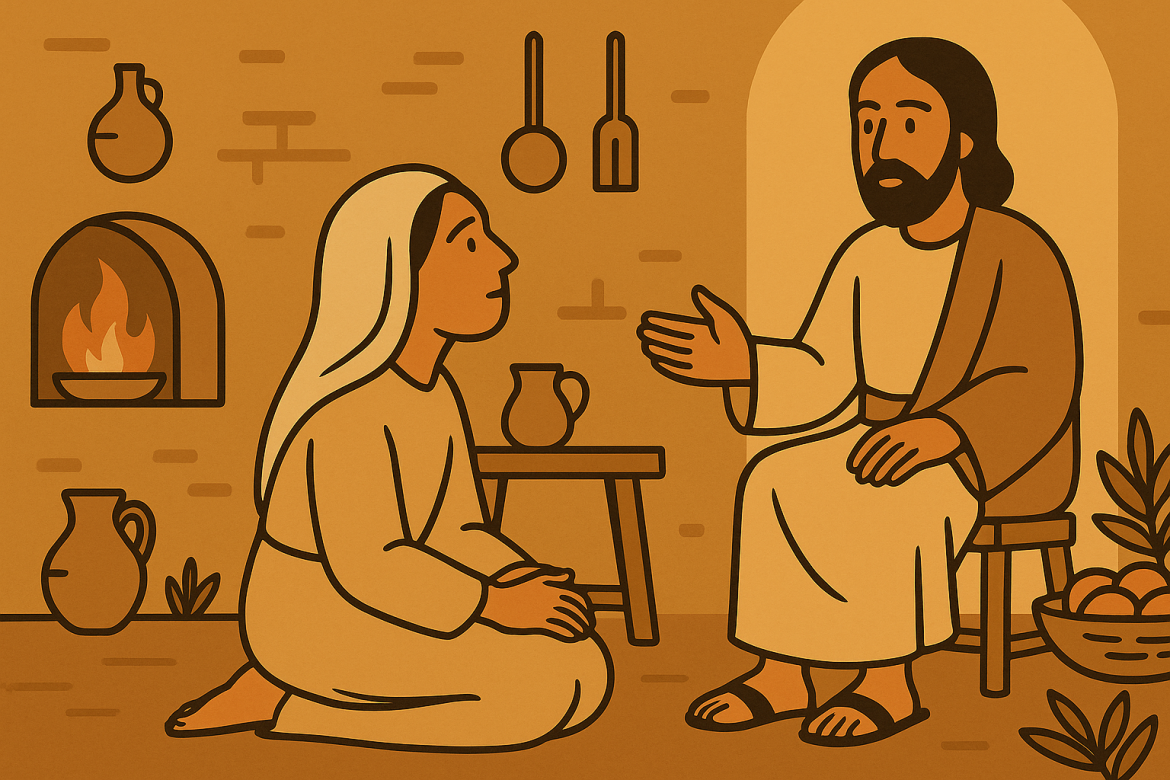In a world that glorifies hustle, applause, and endless motion, the quiet ones can feel invisible. Yet the Gospels highlight a woman whose most powerful moments came not from doing, but from dwelling. Mary of Bethany never led crowds or penned letters like the apostles; her ministry unfolded in silence at the feet of Jesus. Every time she appears in Scripture, she’s found in the same posture—close enough to hear His heartbeat.
Her story is both tender and revolutionary. While others were distracted by duty or driven by doubt, Mary modeled something deeper: the courage to stop striving and simply be with Him. She reminds us that intimacy precedes impact—that worship isn’t noise, it’s nearness. In her stillness, we learn that the truest devotion is not about performance, but presence.
M – Moment
Picture this: the house in Bethany is buzzing, Martha is in motion, guests are around, and Jesus—the Messiah, the Friend—is in the room. And Mary? She does the “impractical” thing. She sits. She listens. She chooses presence over productivity. That single decision becomes the through-line of her whole story. It’s the moment every believer hits eventually: Will I keep doing for Jesus… or will I sit with Jesus? Mary shows us what happens when our first instinct is to drop to His feet—whether in calm, in grief, or in worship.
I – Identity
Mary of Bethany isn’t loud, platformed, or pushy. She’s the contemplative sister in a very active household. Scripture even makes a point to say Jesus loved this family—Martha, Mary, and Lazarus. That tells us something: she was known and loved not because of what she produced, but because of who she was before Him. Her strength wasn’t ambition; it was attention. She was drawn to Jesus’ presence, tuned to His voice, and willing to let that define her more than cultural expectations or sibling dynamics. In a world that rewards the Marthas, Mary reminds us that listening is also worship.
R – Right Choices
Mary makes three stunningly right choices—and all of them happen at Jesus’ feet.
- Luke 10 – The living room choice: While Martha worked, Mary listened. Jesus said she chose “the good part,” and He would not let it be taken from her. She prioritized presence over pressure.
- John 11 – The tomb of Lazarus: When her brother died and Jesus seemed late, she still ran to Him and fell at His feet—this time with tears and confusion: “Lord, if you had been here…” That’s faith that’s honest, not polished.
- John 12 – The anointing: She breaks open expensive nard and pours it on Jesus, wiping His feet with her hair. It was costly, undignified, and criticized—yet Jesus called it preparation for His burial. Extravagant worship is never wasted.
Those three scenes map a disciple’s growth: listening → lamenting → lavish worship.
R – Risks / Wrongs
Mary’s temperament—sensitive, expressive, drawn to stillness—comes with risks. People misunderstood her. Martha thought she was unhelpful. The disciples thought she was wasteful. Some probably thought she was too emotional. That’s the danger of quiet devotion: it’s easy to mislabel as passivity. But Jesus defended her every time: “Leave her alone.” Her “wrongs” weren’t rebellion; they were the misunderstandings that come when you love God in a way others don’t value yet. That’s good news for anyone whose worship looks too tender, too slow, or too costly to others. Jesus reads the heart like we read books.
O – Ongoing Message
Jesus said what she did would be told wherever the gospel is preached. That’s wild—Mary never preached, never led a crowd, never wrote a letter. But her worship outlived her. Her ongoing message is simple and prophetic in our noisy century: the deepest discipleship happens at the feet of Jesus. In a culture that measures worth by output, Mary testifies that nearness is the real measure. Every time someone chooses quiet with God instead of one more task, Mary’s story is echoing.
R – Reflection
So… where are you in Mary’s story?
- Are you in the living room, torn between helping and sitting?
- At the tomb, bringing Jesus your raw disappointment?
- At the banquet, ready to pour out something costly even if people talk?
The transcript you shared makes a great point: transformation doesn’t start in action but in abiding. Imagine the dust on the floor, the weight of the alabaster jar, the hot tears on your cheeks—discipleship is that close, that embodied, that emotional.
S – Steps
Here are some Mary-shaped practices you can give your audience (or yourself):
- Defend stillness. Don’t apologize for needing quiet with Jesus. That’s where clarity is born.
- Bring grief to His feet, not away from Him. Let pain draw you closer, not isolate you. Mary ran toward Him in sorrow.
- Offer something costly. Time, money, reputation, comfort—worship that fills the room always costs something.
- Lead from the shadows. Mary shows that unseen love still shifts history.
- Start the day sitting. Open Scripture before you open tasks—presence before productivity.
And here’s a little angle that would work beautifully for a podcast segment: Mary is proof that quiet stories can thunder through eternity. She is the patron saint of people who don’t want a platform but do want Jesus. Every time someone chooses presence over pressure, her voice is in the room. That’s a compelling contrast your listeners will relate to—especially believers burned out on constantly “doing for God.”
Bottom line: Mary never tried to impress Jesus—she just stayed near Him. And Jesus kept saying, in scene after scene, “That’s the right thing.” If your listeners are wondering whether listening is enough, this story says: yes. Sitting at His feet is the most important thing you will ever do.

